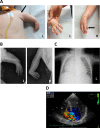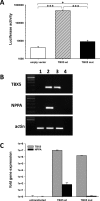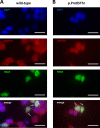A novel de novo TBX5 mutation in a patient with Holt-Oram syndrome leading to a dramatically reduced biological function
- PMID: 27652283
- PMCID: PMC5023941
- DOI: 10.1002/mgg3.234
A novel de novo TBX5 mutation in a patient with Holt-Oram syndrome leading to a dramatically reduced biological function
Abstract
Background: The Holt-Oram syndrome (HOS) is an autosomal dominant disorder affecting 1/100.000 live births. It is defined by upper limb anomalies and congenital heart defects with variable severity. We describe a dramatic phenotype of a male, 15-month-old patient being investigated for strict diagnostic criteria of HOS.
Methods and results: Genetic analysis revealed a so far unpublished TBX5 mutation, which occurs de novo in the patient with healthy parents. TBX5 belongs to the large family of T-box transcription factors playing major roles in morphogenesis and cell-type specification. The mutation located in the DNA-binding domain at position 920 (C→A) leads to an amino acid change at position 85 (proline → threonine). Three-dimensional analysis of the protein structure predicted a cis to trans change in the respective peptide bond, thereby probably provoking major conformational and functional alterations of the protein. The p.Pro85Thr mutation showed a dramatically reduced activation (97%) of the NPPA promoter in luciferase assays and failed to induce NPPA expression in HEK 293 cells compared to wild-type TBX5 protein. The mutation did not interfere with the nuclear localization of the protein.
Conclusion: These results suggest that the dramatic functional alteration of the p.Pro85Thr mutation leads to the distinctive phenotype of the patient.
Keywords: Congenital heart disease; Holt–Oram syndrome; TBX5; de novo mutation; heart‐hand syndrome; loss‐of function; transcription factor.
Figures





Similar articles
-
A gain-of-function TBX5 mutation is associated with atypical Holt-Oram syndrome and paroxysmal atrial fibrillation.Circ Res. 2008 Jun 6;102(11):1433-42. doi: 10.1161/CIRCRESAHA.107.168294. Epub 2008 May 1. Circ Res. 2008. PMID: 18451335
-
Functional analysis of two novel TBX5 variants present in individuals with Holt-Oram syndrome with different clinical manifestations.Mol Genet Genomics. 2021 Jul;296(4):809-821. doi: 10.1007/s00438-021-01781-2. Epub 2021 Apr 17. Mol Genet Genomics. 2021. PMID: 33866394
-
A novel de novo TBX5 mutation in a patient with Holt-Oram syndrome.Appl Clin Genet. 2018 Nov 23;11:157-162. doi: 10.2147/TACG.S183418. eCollection 2018. Appl Clin Genet. 2018. PMID: 30538526 Free PMC article.
-
TBX5 mutations and congenital heart disease: Holt-Oram syndrome revealed.Curr Opin Cardiol. 2004 May;19(3):211-5. doi: 10.1097/00001573-200405000-00004. Curr Opin Cardiol. 2004. PMID: 15096952 Review.
-
Molecular basis of the clinical features of Holt-Oram syndrome resulting from missense and extended protein mutations of the TBX5 gene as well as TBX5 intragenic duplications.Gene. 2015 Apr 15;560(2):129-36. doi: 10.1016/j.gene.2015.02.017. Epub 2015 Feb 11. Gene. 2015. PMID: 25680289 Review.
Cited by
-
Association of NKX2-5, GATA4, and TBX5 polymorphisms with congenital heart disease in Egyptian children.Mol Genet Genomic Med. 2019 May;7(5):e612. doi: 10.1002/mgg3.612. Epub 2019 Mar 4. Mol Genet Genomic Med. 2019. PMID: 30834692 Free PMC article.
-
Identification of a novel TBX5 mutation in a Chinese family with rare symptoms of Holt-Oram syndrome.Heliyon. 2022 Nov 21;8(11):e11774. doi: 10.1016/j.heliyon.2022.e11774. eCollection 2022 Nov. Heliyon. 2022. PMID: 36444245 Free PMC article.
-
Identification of a novel non-sense mutation in TBX5 gene in pediatric patients with congenital heart defects.J Cardiovasc Thorac Res. 2018;10(1):41-45. doi: 10.15171/jcvtr.2018.07. Epub 2018 Mar 17. J Cardiovasc Thorac Res. 2018. PMID: 29707177 Free PMC article.
-
Congenital heart disease missense mutations in the TBX5 DNA-binding domain alter thermal stability and DNA-binding affinity.bioRxiv [Preprint]. 2025 May 17:2025.05.16.654568. doi: 10.1101/2025.05.16.654568. bioRxiv. 2025. Update in: G3 (Bethesda). 2025 Aug 02:jkaf174. doi: 10.1093/g3journal/jkaf174. PMID: 40463096 Free PMC article. Updated. Preprint.
-
Electrical disorders in atrial septal defect: genetics and heritability.J Thorac Dis. 2018 Sep;10(Suppl 24):S2848-S2853. doi: 10.21037/jtd.2018.02.53. J Thorac Dis. 2018. PMID: 30305944 Free PMC article. Review.
References
-
- Al‐Qattan, M. M. , and Abou Al‐Shaar H.. 2015. Molecular basis of the clinical features of Holt‐Oram syndrome resulting from missense and extended protein mutations of the TBX5 gene as well as TBX5 intragenic duplications. Gene 560:129–136. - PubMed
-
- Baban, A. , Postma A. V., Marini M., Trocchio G., Santilli A., Pelegrini M., et al. 2014. Identification of TBX5 mutations in a series of 94 patients with Tetralogy of Fallot. Am. J. Med. Genet. A 164A:3100–3107. - PubMed
-
- Bamshad, M. , Lin R. C., Law D. J., Watkins W. C., Krakowiak P. A., Moore M. E., et al. 1997. Mutations in human TBX3 alter limb, apocrine and genital development in ulnar‐mammary syndrome. Nat. Genet. 16:311–315. - PubMed
-
- Basson, C. T. , Cowley G. S., Solomon S. D., Weissman B., Poznanski A. K., Traill T. A., et al. 1994. The clinical and genetic spectrum of the Holt‐Oram syndrome (heart‐hand syndrome). N. Engl. J. Med. 330:885–891. - PubMed
-
- Basson, C. T. , Bachinsky D. R., Lin R. C., Levi T., Elkins J. A., Soults J., et al. 1997. Mutations in human TBX5 [corrected] cause limb and cardiac malformation in Holt‐Oram syndrome. Nat. Genet. 15:30–35. - PubMed
LinkOut - more resources
Full Text Sources
Other Literature Sources
Miscellaneous

